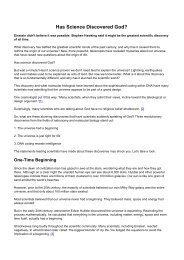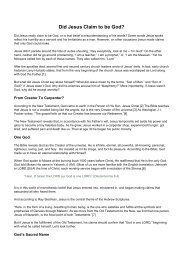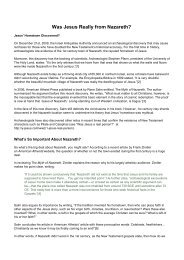missing_link6
You also want an ePaper? Increase the reach of your titles
YUMPU automatically turns print PDFs into web optimized ePapers that Google loves.
The discovery of DNA has revolutionized the<br />
world of forensic evidence. Cold case files<br />
have been reopened. Criminals who thought<br />
they had beaten the system have been<br />
belatedly prosecuted by a swab of saliva or<br />
body fluids forgotten about for decades. And<br />
in some instances, the new evidence has<br />
exonerated innocent prisoners.<br />
Herman Atkins was just 20 years old when<br />
his life began to fall apart. He was imprisoned<br />
in January, 1986 for wounding three<br />
people in a shooting spree in South-Central<br />
Los Angeles. Prior to his imprisonment a<br />
“Wanted” poster had been widely circulated.<br />
Later, at a sheriff’s substation, a 23 year-old<br />
rape victim glanced at a “Wanted” poster on<br />
a nearby table that showed a young black<br />
fugitive from Los Angeles. In court, she testified<br />
that she turned to her mother and said,<br />
“That’s him,” and pointed at the picture of<br />
Herman Atkins.<br />
A clerk from an adjoining business where<br />
the attacker stopped briefly before the rape<br />
also identified Atkins. Based primarily upon<br />
these eyewitness testimonies, the jury found<br />
Herman Atkins guilty of rape and robbery.<br />
His sentence: 47 years, 8 months in prison.<br />
Atkins spent thirteen years, three months,<br />
and six days in state prison, but not for a<br />
crime he had committed. His cold case had<br />
been reopened, and the DNA evidence had<br />
revealed that Atkins was not the rapist. On<br />
February 18, 2000 he walked out a free man,<br />
the victim of mistaken identity.<br />
Just as DNA has revolutionized criminal<br />
forensics, the work of paleontologists has<br />
shed new light on human origins. Being an<br />
honest man, Charles Darwin made no bones<br />
(pardon the pun) about predicting that the<br />
forensic fossil evidence would ultimately<br />
prove his theory right or wrong.<br />
But just as experts can jump to the wrong<br />
conclusion with regard to criminal evidence,<br />
so in the world of paleontology, a tooth, jaw,<br />
or piece of skull has often created premature<br />
headlines of “Missing Link Found.” Paleontologist<br />
Michael Boulter summarizes the<br />
problem with identifying fossils correctly:<br />
It’s very hard to piece together a few<br />
broken bones from a fossilized group<br />
of differentially aged primates scattered<br />
over a desert or cave floor and to<br />
be sure that they come from the same<br />
animal….It follows that the reliability<br />
of any description that attempts to<br />
recognize an actual species cannot be<br />
totally objective. 1<br />
Boulter is alluding to the fact that, being human,<br />
most scientists look at a fossil through<br />
the lens of their own presuppositions. For example,<br />
those who wanted to make a case for<br />
humans descending from apes were quick<br />
to jump with joy over the supposed discovery<br />
of the “<strong>missing</strong> link” called Piltdown Man.<br />
Featured in the London Times, New York<br />
Times, and various science journals, they<br />
made it a textbook example of the connection<br />
between apes and humans. However,<br />
forty years later, in 1953, it was revealed as<br />
a fraud.<br />
Frauds like the Piltdown Man are rare, and<br />
although objectivity is often lacking, there is<br />
actually a wealth of fossil evidence depicting<br />
the history of life on our planet.<br />
So in order to see what the forensic evidence<br />
says about Darwin’s theory, we need to<br />
hear from paleontologists themselves about<br />
6 • THE CASE OF THE MISSING LINK • ARTICLE 6
















